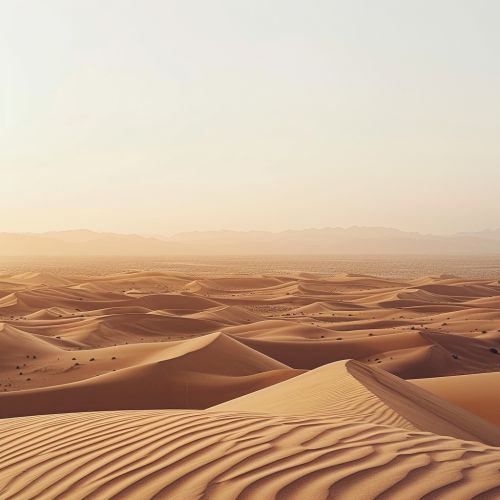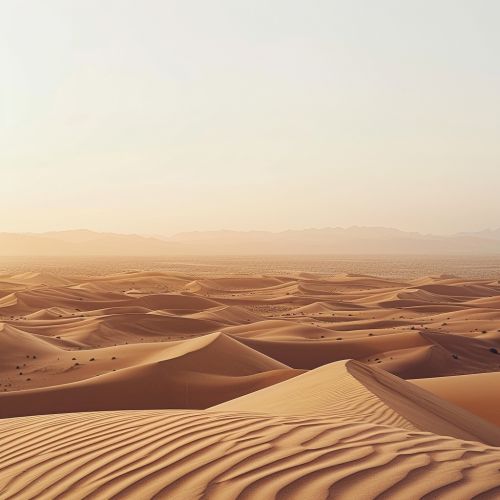Arabian Peninsula
Geography
The Arabian Peninsula is a vast landmass situated in the southwestern region of Asia. It is bordered by the Red Sea to the west, the Arabian Sea to the southeast, and the Persian Gulf to the northeast. The peninsula covers an area of approximately 3.2 million square kilometers, making it the largest peninsula in the world. It is characterized by its arid climate, with vast deserts such as the Rub' al Khali (Empty Quarter), which is one of the largest continuous sand deserts in the world.


The topography of the Arabian Peninsula is diverse, featuring mountain ranges such as the Sarawat Mountains in the west, which include the Asir and Hijaz ranges. The highest peak in the peninsula is Jebel al-Nabi Shu'ayb in Yemen, standing at 3,666 meters. Coastal plains, known as Tihamah, run along the western and southern coasts, while the eastern region is dominated by the Al-Hasa and Al-Dahna deserts.
Climate
The climate of the Arabian Peninsula is predominantly arid, with extremely high temperatures during the summer months, often exceeding 50°C in some areas. The region experiences very low annual rainfall, with some areas receiving less than 100 millimeters per year. The coastal areas, however, benefit from higher humidity levels and slightly more precipitation.
The peninsula's climate is influenced by its geographical location and topography. The northern parts experience a desert climate, while the southern regions, particularly in Yemen and Oman, have a semi-arid to tropical climate due to the influence of the Indian Ocean monsoon.
Flora and Fauna
Despite its harsh climate, the Arabian Peninsula supports a variety of flora and fauna. The vegetation is primarily xerophytic, adapted to survive in arid conditions. Common plant species include acacia, date palms, and various types of shrubs and grasses. The coastal regions and oases support more diverse plant life, including mangroves and agricultural crops such as wheat, barley, and fruits.
The fauna of the Arabian Peninsula includes several species adapted to the desert environment. Notable animals include the Arabian oryx, sand gazelle, and the Arabian leopard. The region is also home to various reptiles, birds, and insects. The coastal waters are rich in marine life, including fish, crustaceans, and coral reefs.
History
The Arabian Peninsula has a rich and complex history, dating back to ancient times. It is considered the cradle of Arab civilization and the birthplace of Islam. The region has been inhabited by various tribes and civilizations, including the Nabateans, Thamud, and Sabaeans.
The rise of Islam in the 7th century CE significantly shaped the history and culture of the Arabian Peninsula. The Prophet Muhammad was born in Mecca, and the region became the center of the Islamic world. The Rashidun, Umayyad, Abbasid, and Ottoman caliphates all had a profound impact on the political and cultural development of the peninsula.
In the modern era, the discovery of oil in the early 20th century transformed the economies and societies of the Arabian Peninsula. Countries such as Saudi Arabia, Kuwait, and the United Arab Emirates became major global players in the oil industry, leading to rapid modernization and economic growth.
Economy
The economy of the Arabian Peninsula is heavily reliant on the extraction and export of oil and natural gas. Saudi Arabia, the largest country on the peninsula, holds the world's second-largest proven oil reserves and is the leading oil exporter. The economies of Kuwait, Qatar, the United Arab Emirates, and Oman are also significantly dependent on hydrocarbon resources.
In recent years, there has been a push towards economic diversification to reduce dependence on oil revenues. Countries in the region are investing in sectors such as tourism, finance, real estate, and renewable energy. The Vision 2030 initiative in Saudi Arabia aims to transform the country's economy by promoting non-oil industries and increasing foreign investment.
Culture
The culture of the Arabian Peninsula is deeply rooted in its Islamic heritage and Bedouin traditions. Arabic is the predominant language, and Islam is the dominant religion. The region is known for its rich traditions in poetry, music, and dance. Traditional forms of music include the oud and the rebab, while dance forms such as the Ardah are performed during cultural and religious celebrations.
Hospitality is a significant aspect of Arabian culture, with customs such as the offering of coffee and dates to guests being common. The cuisine of the Arabian Peninsula is diverse, featuring dishes such as kabsa, mandi, and hummus. The use of spices, herbs, and ingredients like dates, rice, and lamb is prevalent in the regional cuisine.
Politics
The Arabian Peninsula is politically diverse, comprising several sovereign states, including Saudi Arabia, Yemen, Oman, the United Arab Emirates, Kuwait, Qatar, and Bahrain. The political systems in these countries range from absolute monarchies to republics.
Saudi Arabia, the largest and most influential country on the peninsula, is an absolute monarchy with significant political and economic influence in the region. Yemen, on the other hand, has experienced prolonged political instability and conflict, particularly since the outbreak of the civil war in 2015.
The Gulf Cooperation Council (GCC) is a regional political and economic alliance that includes Saudi Arabia, Kuwait, the United Arab Emirates, Qatar, Bahrain, and Oman. The GCC aims to promote economic integration and cooperation among its member states.
Demographics
The population of the Arabian Peninsula is diverse, with a mix of ethnicities, languages, and cultures. The majority of the population is Arab, with significant expatriate communities from South Asia, Southeast Asia, and other regions. The total population of the peninsula is estimated to be over 80 million people.
Urbanization is a notable trend in the region, with major cities such as Riyadh, Dubai, Jeddah, and Abu Dhabi experiencing rapid growth. These cities are characterized by modern infrastructure, skyscrapers, and a high standard of living.
Religion
Islam is the predominant religion in the Arabian Peninsula, with the majority of the population adhering to Sunni Islam. There are also significant Shia Muslim communities, particularly in eastern Saudi Arabia, Bahrain, and parts of Yemen. The region is home to the two holiest cities in Islam, Mecca and Medina, which attract millions of Muslim pilgrims annually.
Religious practices and beliefs play a central role in the daily lives of the people in the Arabian Peninsula. The region observes Islamic holidays such as Ramadan, Eid al-Fitr, and Eid al-Adha with great reverence and celebration.
Transportation
Transportation infrastructure in the Arabian Peninsula has seen significant development in recent decades. The region boasts modern highways, airports, and seaports that facilitate domestic and international travel. Major airlines such as Emirates, Qatar Airways, and Saudi Arabian Airlines connect the peninsula to global destinations.
The construction of high-speed rail networks, such as the Haramain High-Speed Railway in Saudi Arabia, has improved connectivity between major cities. Public transportation systems, including metro networks in cities like Dubai and Riyadh, are also being expanded to accommodate growing urban populations.
Challenges and Future Prospects
The Arabian Peninsula faces several challenges, including political instability, economic diversification, and environmental sustainability. The ongoing conflict in Yemen has created a humanitarian crisis, while the reliance on oil revenues poses economic risks due to fluctuating global oil prices.
Efforts to address these challenges include initiatives to promote renewable energy, such as solar and wind power, and investments in education and technology to build a knowledge-based economy. The region's strategic location and natural resources continue to offer significant opportunities for growth and development.
